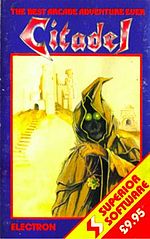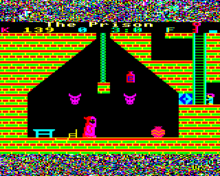- Citadel (video game)
-
For the 1989 video game, see Citadel: Adventure of the Crystal Keep.
Citadel 
Publisher(s) Superior Software Designer(s) Michael Jakobsen Platform(s) BBC Micro, Acorn Electron Release date(s) 1985 Genre(s) Platform game, Puzzle game Mode(s) Single player Media/distribution cassette, floppy disk System requirements 32kb
Citadel is a computer game released in 1985 for the Acorn Electron and BBC Micro by Superior Software. A platform game with some puzzle solving elements, the game's plot involves finding five crystals hidden in various locations in a large castle, together with areas outside it (including a wasteland, a pyramid, a sea and an island) and returning them to their rightful place.
Upon returning the crystals, the player must teleport to a separate set of locations to complete the game. Once the game is completed, the player is left free to roam the castle in order to achieve the maximum possible score if they have not done so already. The only way to see the final congratulatory message is to reach 99 points.
Contents
Gameplay
Citadel has a number of distinctive features. Unlike many other Platform games, the player is not automatically killed if they come into contact with fireballs, snakes or other hazards; instead the player is allocated a set amount of energy, measured by a number, which is depleted through contact, which can be replenished by collecting objects shaped like bottles. If the player continuously loses too much energy in a room, the screen turns red and the player is transported back to where they entered the room. This prevents players from passing through a room simply by walking through enemies and taking the damage.
The game also allows the player to choose the sex of their character and uses a different sprite accordingly - quite unusual in the days when in-game memory was at a premium (although the chosen gender of the sprite does not affect gameplay). The player sprite is not superimposed over objects that it walks "in front" of; rather, the colour of the pixels of the character sprite is overlaid, using an XOR bitwise operation, with the colour of the superimposed object, resulting in a completely different colour. For instance, the male player sprite normally has pink hair and yellow skin, but has yellow hair and pink skin when placed in front of the cyan stones of the Stonehenge screen. This effect is quite distinctive (it was also used in the two "sequels").
Most enemies cannot be destroyed, only avoided. The exceptions to this are the 'monks' which can be destroyed by jumping and firing a projectile-like 'spell' into their face. Each spell expends one unit of energy, which is restored if the player is successful in killing the monk. If a player returns to a room where they had previously destroyed a monk, the monk reappears and must be killed again, often employing a different technique if the room was entered by a different way.
In addition to the crystals, various other items are located throughout the castle which can be collected and used to solve puzzles in order to obtain the crystals. These include coloured keys which open doors of the same colour, giving access to other areas of the game; an 'ice crystal' which, whilst carried, causes water in its vicinity to freeze, enabling access to previously inaccessible areas; trampolines which can be jumped on to reach high areas ordinarily out of reach, and many others.
The player is limited to carrying two items at any one time and a certain combination of objects in their inventory is often needed to solve particular problems. For example, one crystal is located in a room behind a brick wall. Access is obtained by finding a cannonball and sack of gunpowder and then walking past a cannon. These items are then automatically 'loaded' into the cannon which fires, blasting a hole in the brick wall giving access to the crystal behind.
Most of the items scattered throughout the game are needed to complete it, with the exception of the barrel (which can be used as a platform to jump to a higher area, although the same effect can be achieved with the trampoline), and the metal bars, which can be taken to the Stonehenge screen to be converted into energy, but add no points to the player's score.
Ports
The BBC Micro game screens are identical to their Electron counterparts except that they lack the multicoloured top and bottom borders - this multicoloured border was actually machine code, that was left on-screen as 'decoration' rather than use more memory to hide it. The numbers below the name of the screen ("The Prison" in this case) indicate the number of units of energy left, the player's score, and two coordinates indicating the location of the screen. The letter next to the key which is being carried in the inventory was used by players who only had access to a monochrome monitor.
Trivia
Citadel was unusual at the time for playing digitised speech before loading the main game (in part to advertise Superior Software's "Speech!" programme package), as well as having other special effects advanced for the time, such as splashing water sounds.
As with most Superior Software games during this period, there was a prize associated with Citadel. The winner was the first person to find three crowns which were hidden around the game map. It is possible for the player to complete the game without picking up the crowns, although the player cannot see the final congratulatory message if they are not collected.
Citadel received a great deal of acclaim at the time of its release, and remains one of the classic BBC Micro games. The game Palace of Magic, released in 1987, used extremely similar gameplay principles, and was in a way a de facto sequel. Although subsequent games from Superior, such as Baron, Ricochet and Quest, used many of the same elements — though without achieving the same cult status — an official sequel to the game was not released until 1993 when Superior decided to release The Fort, yet another such game, as Citadel 2.[1] However by this time the BBC Micro was declining in popularity — Citadel 2, written by "Symo" (Simon Storr) was one of the last BBC Micro games released — and the sequel is little known.
References
Superior Software Games Bonecruncher · Camelot · Citadel · Citadel 2 · Cosmic Camouflage · Deathstar · Elixir · Exile · Firetrack · Grand Prix Construction Set · Hyperball · Overdrive · Palace of Magic · Pipeline · Qwak · Ravenskull · Repton (and sequels) · Ricochet · Syncron · Thrust · ZarchCategories:- 1985 video games
- BBC Micro and Acorn Electron games
- Platform games
- Superior Software games
Wikimedia Foundation. 2010.

